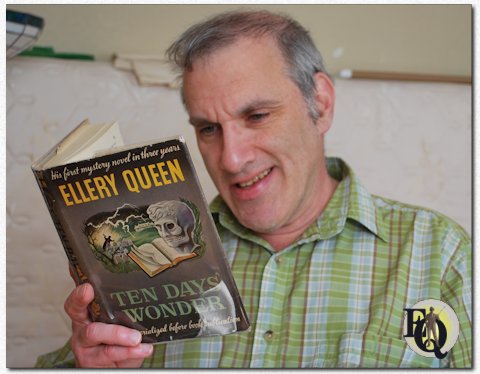


![]()
|
Arthur Vidro  Arthur
Vidro kwam voor het eerst in contact met
Ellery Queen in 1975 toen
hij naar de eerste aflevering van NBC’s
Ellery Queen keek. Alles
leek er op te wijzen dat dit liefde op het
eerste gezicht was. Arthur begon al snel aan
het lezen van de volledige Queen bibliotheek
en kwam zelfs tot de ontdekking (ah, de
magie van het toeval, zelfs in de echte
wereld) dat zijn wiskunde lerares Frederic
Dannay’s schoondochter was, echtgenote van
Douglas Dannay, zo werd Arthur bekend
bij zowel de Dannays en Lees. In zijn
volwassen leven omarmde Arthur de werken van
Queen met veel toewijding. Drie maal per jaar
geeft hij het detective magazine (Give Me
That) Old-Time Detection uit, waarvan
verschillende uitgaves aan het werk van Queen
zijn gewijd. Achter de scene had Arthur ook
een hand in de uitgave van Crippen and
Landru's meest recente Ellery Queen
uitgaves,
The Tragedy of Errors and
The
Adventure of the Murdered Moths.
Zeer recentelijk in September van 2013
Arthur dirigeerde hij de wereld première van
Joseph Goodrich’s toneelstuk
Calamity Town, gebaseerd op het eerste
Wrightsville mysterie. Alsof dit nog niet
genoeg was verscheen hij in deze productie
ook op het toneel als Wrightsville
vastgoedmakelaar J.C. Pettigrew. Arthur
Vidro kwam voor het eerst in contact met
Ellery Queen in 1975 toen
hij naar de eerste aflevering van NBC’s
Ellery Queen keek. Alles
leek er op te wijzen dat dit liefde op het
eerste gezicht was. Arthur begon al snel aan
het lezen van de volledige Queen bibliotheek
en kwam zelfs tot de ontdekking (ah, de
magie van het toeval, zelfs in de echte
wereld) dat zijn wiskunde lerares Frederic
Dannay’s schoondochter was, echtgenote van
Douglas Dannay, zo werd Arthur bekend
bij zowel de Dannays en Lees. In zijn
volwassen leven omarmde Arthur de werken van
Queen met veel toewijding. Drie maal per jaar
geeft hij het detective magazine (Give Me
That) Old-Time Detection uit, waarvan
verschillende uitgaves aan het werk van Queen
zijn gewijd. Achter de scene had Arthur ook
een hand in de uitgave van Crippen and
Landru's meest recente Ellery Queen
uitgaves,
The Tragedy of Errors and
The
Adventure of the Murdered Moths.
Zeer recentelijk in September van 2013
Arthur dirigeerde hij de wereld première van
Joseph Goodrich’s toneelstuk
Calamity Town, gebaseerd op het eerste
Wrightsville mysterie. Alsof dit nog niet
genoeg was verscheen hij in deze productie
ook op het toneel als Wrightsville
vastgoedmakelaar J.C. Pettigrew. Arthur’s 87th Street Irregular essay is mooi stuk -- hij doet in detail uit de doeken waarom Claremont, New Hampshire (waar Arthur ook woont en waar Calamity Town werd opgevoerd door de Off Broad Street Players) wellicht het model was voor Wrightsville. Een intrigerende oefening die iedereen zal smaken! Dus, een welverdiend welkom voor ons nieuwste lid van de 87th Street Irregulars, Arthur Vidro. (Oh, hebben we al vermeld dat Arthur’s thuisadres in Claremont toevallig gelegen is . . . in Ellery Street?)
Kurt Sercu |


|
CLAREMONT: THE REAL WRIGHTSVILLE Mystery writer Ellery Queen frequently visited Claremont, and fictional detective Ellery Queen solved several cases in a town based on Claremont.Who was Ellery Queen and why would he often find himself in Claremont? Ellery Queen was a top-rank author of mysteries. His first mystery novel was published in 1929, his final one in 1971. The detective featured in most of the cases was also named Ellery Queen. From the 1930s through the 1970s Ellery Queen was one of the most famous and popular of fictional detectives. He appeared in novels, short stories, movies, radio, television, and even comic books. “Ellery Queen” was created in 1928 by Frederic Dannay (1905–1982) and Manfred B. Lee (1905–1971), a pair of first cousins in New York who collaborated to enter a fiction contest. Their submission, titled The Roman Hat Mystery, was published in 1929 and featured as its hero Ellery Queen, an amateur sleuth who solves crimes. The contest’s rules required that every manuscript be entered under a pseudonym. The cousins chose Ellery Queen as their joint byline for the book. The fictional character of Ellery Queen is himself a writer of detective stories. Now let’s talk about Claremont. The Miller Family Manny Lee is Claremont’s connection to Ellery Queen. Manny Lee would visit Claremont because he married into Claremont’s Miller Family. The Millers emigrated from Russia at around the turn of the twentieth century and settled in Claremont because they knew people there. At the time, Hirsch (also known as Harry) and Dore (also known as Dora) Miller had five children, all born in the old country. Those kids were Baruch (Bert), David (Dave), Hyman (Hy), Benjamin (Ben), and Goldie. Two more girls were born in Claremont: Ida (May 25, 1907) and Bess (July 30, 1909). Those two births are recorded in Claremont City Hall’s Vital Records department. A Claremont directory from 1914 shows Harry Miller having a dry goods and clothing store at 147 Main Street, with a house at 145. A Claremont directory from 1923 shows Harry B. Miller having a dry goods, clothing, and grocery store at 162–164 Main Street. Possibly the house was 162 and the store 164. The youngest child, Bess, was known to her friends as Betty. She lived in Claremont into her teens. In 1927 Betty Miller married Manny Lee. By that time many of the Millers, including Betty, had moved to Philadelphia, but there were still kinfolk in Claremont that prompted several visits. How did a Claremont gal hook up with a New York City man? Betty’s older brother Hyman provided that link. In the words of Patricia Lee Caldwell, a daughter of Manny Lee and Claremont-born Betty Miller: My Uncle Hy attended college at New York University and there met my father [Manny Lee], also a student there. The story goes that they met on a subway platform, where my gregarious uncle introduced himself to Dad. It turned out that they were both musical (Dad played the fiddle and Uncle Hy had a great singing voice and perhaps played some instrument), and some time later they formed a band with three or four other students and performed, I think, in various venues, including on some cruises and at some vacation spots. At some point in 1926 Hy brought his friend and fellow band member Manny Lee to Philadelphia for a weekend to meet the family. That weekend, Manny Lee met Claremont-born Betty Miller. The next year Manny and Betty were wed. Soon after, Ellery Queen was born. Manny and Betty would separate in 1938 and divorce in 1941, but Claremont left its mark on Manny. When the Queen cousins decided to place sleuth Ellery into a small-town setting in New England, they created Wrightsville, which incorporates many features of Claremont. “I remember clearly that my mother told me that Wrightsville was based on Claremont,” says Patricia Lee Caldwell. In fact, the old Claremont Eagle newspaper provided front-page coverage (on July 10, 1959) of a talk Manny Lee gave in Claremont, in which he revealed that the Wrightsville setting for several Queen books was indeed based on Claremont. The state’s Union-Leader newspaper covered that talk too. Fran Weiss, who now lives in New Jersey, lived on Sullivan Street in Claremont from November 1958 until the Spring of 1960. Fran attended that 1959 talk. She recalls: I was surprised to discover that the famous EQ was actually two different men. During my stay in Claremont, I was bureau chief for the Manchester Union-Leader, so the article I wrote appeared there. As an underpaid reporter, I also enjoyed a free meal. I took photos whenever I could, as I was paid $3 for each one the paper printed. (I paid for film, and the camera was my own.) I’m pretty sure they used the one of “Ellery Queen”. The first three Wrightsville novels are first-rate mysteries and far superior to the others, but Double, Double offers a special treat to Claremonters. Its original end papers are decorated with a map of Wrightsville, which looks remarkably like Claremont. Both towns have a round Square with five streets hooked up to it, like spokes from a wheel. (Claremont has Main, Sullivan, Pleasant, Broad, and Tremont; Wrightsville has Washington, Lincoln, Upper Dade, State, and Lower Main.) Both towns have a bandstand right off the Square. References to High Village and Low Village in Wrightsville have a foundation in Claremont. The Hollis Hotel in Wrightsville could easily be The Hotel Moody in Claremont. Wrightsville and Claremont each has a small airport. Wrightsville and Claremont share a similar size. Even the distance from Claremont’s Amtrak station into town matches the distance for a corresponding train in Wrightsville. Plus, certain circumstances about Wrightsville — such as the railroad’s coming all the way into town for an additional stop, and the daily newspaper’s offices being located on the Square —were true in Claremont’s mid-20th century days though not today. Sole Mention of Claremont The earlier Queen books all featured a foreword by a fictitious judge named J.J. McC, who added to the misbelieve of many that Ellery Queen was a real person. Most of J.J.’s forewords bore the dateline New York. However, the foreword in The Siamese Twin Mystery (1933) bears this dateline: “Claremont, N.H.”  Above: Arthur Vidro has embraced the works of Ellery with fervor. © Original photo Arthur Vidro Used by permission |
|
|
©
Original
text
(first published in CADS 67, Mar 2014)
2013
Arthur Vidro Other articles by this West 87nd Street Irregular (1) "Ten Days' Wonder" by Ellery Queen (review by Arthur Vidro) at Something is going to Happen (Jul 12. 2017) (2) "Old-Time Detection: Best Mystery Writers" featuring Arthur Vidro by Leigh Lundin (Jan 17. 2016)
Page first published on June 1.
2014 |
|
|
|

|
|
| Inleiding | Plattegrond | Q.B.I. | Liist Verdachten | Wie? | Q.E.D.
| Moord en
scene | Nieuw |
Auteursrecht Copyright © MCMXCIX-MMXXV Ellery Queen, een website rond deductie. Alle rechten voorbehouden. |